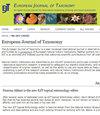Two new species of Scolopocryptops centipedes from southern Japan (Chilopoda: Scolopendromorpha: Scolopocryptopidae)
IF 1.3
3区 生物学
Q3 ENTOMOLOGY
引用次数: 0
Abstract
The blind centipede genus Scolopocryptops Newport, 1844 comprises two lineages: the “Asian/North American” group and the “Neotropical/Afrotropical” group. The former can be further split into two groups, a clade comprising Scolopocryptops elegans (Takakuwa, 1937) and Scolopocryptops curtus (Takakuwa, 1939), and a clade comprising all other “Asian/North American” species. Here, Scolopocryptops miyosii sp. nov. from Kyushu and Amami Island and Scolopocryptops brevisulcatus sp. nov. from Izena Island and Okinawa Island in southern Japan are described. The two new species have external features similar to S. elegans and S. curtus. They can be distinguished from most other “Asian/North American” Scolopocryptops by the absence of complete sulcus/sulci along the lateral margin of the cephalic plate and the presence of sternal longitudinal sulci. They can be distinguished from each other by several external features, such as the density of antennal setae and the shape of the anterior margin of the coxosternite. Phylogenetic analyses using nuclear and mitochondrial markers also support the monophyly of the four species, which form a clade sister to all other “Asian/North American” Scolopocryptops.日本南部的两种新蜈蚣 (Chilopoda: Scolopendromorpha: Scolopocryptopidae)
盲蜈蚣属(Scolopocryptops Newport,1844 年)包括两个支系:"亚洲/北美 "支系和 "新热带/非热带 "支系。前者又可进一步分为两类,一类是由 Scolopocryptops elegans(Takakuwa,1937 年)和 Scolopocryptops curtus(Takakuwa,1939 年)组成的支系,另一类是由所有其他 "亚洲/北美 "物种组成的支系。本文描述了产自日本九州和奄美岛的新种Scolopocryptops miyosii和产自日本南部伊势名岛和冲绳岛的新种Scolopocryptops brevisulcatus。这两个新物种的外部特征与 S. elegans 和 S. curtus 相似。它们与其他大多数 "亚洲/北美 "Scolopocryptops的区别在于头板侧缘没有完整的沟/槽,而存在胸骨纵沟。它们可以通过一些外部特征区分开来,如触角刚毛的密度和尾骨前缘的形状。利用核标记和线粒体标记进行的系统发育分析也支持这四个物种的单系性,它们与所有其他 "亚洲/北美 "Scolopocryptops组成一个姊妹支系。
本文章由计算机程序翻译,如有差异,请以英文原文为准。
求助全文
约1分钟内获得全文
求助全文
来源期刊

European journal of taxonomy
ZOOLOGY-
CiteScore
2.30
自引率
8.30%
发文量
173
审稿时长
29 weeks
期刊介绍:
EJT is a fully refereed, international, fully electronic Open Access journal in descriptive taxonomy, covering subjects in zoology, entomology, botany (in its broadest sense), and palaeontology. EJT-papers must be original and adhere to high scientific (content) and technical (language, artwork, etc.) standards. Manuscripts that are clearly substandard in either of these categories will not be sent out for review. EJT is supported by a consortium of European Natural History Institutes, but its scope is global. Both authorship and geographical region of study need not be European. Authors are, however, strongly encouraged to involve European Natural History collections by consulting material or by depositing specimens (e.g. types and figured material) related to their published paper in the collection of a European Natural History Institute.
 求助内容:
求助内容: 应助结果提醒方式:
应助结果提醒方式:


